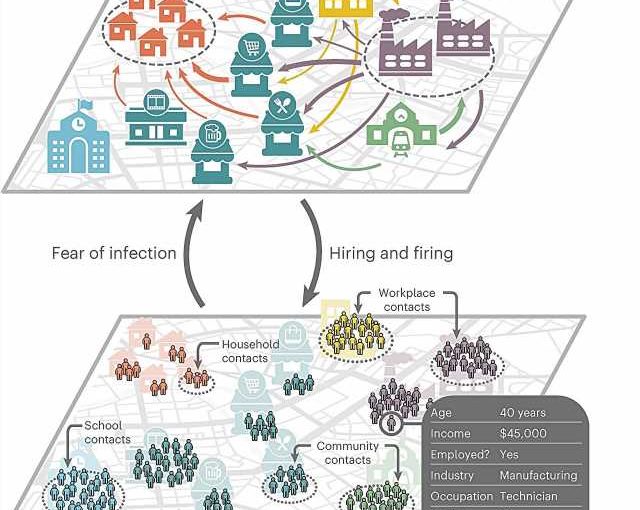
Is lockdown an effective response to a pandemic, or would it be better to let individuals spontaneously reduce their risk of infection? Research published today suggests these two highly-debated options lead to similar outcomes.
A ground-breaking economic-pandemic model, created by an international team of researchers, addresses some of the key policy debates of the COVID-19 pandemic but it will, in future, enable governments and policymakers to take tough decisions—and assess effective actions.
The modeling, designed by the team, including Oxford experts, has been tested using data from New York city responses to COVID-19—and it accurately predicted both death rates and the impact on the city’s economy of the first wave of the pandemic.
Professor Doyne Farmer, Director of the Complexity Economics Programme at INET Oxford, says the research paper is timely, given the COVID-19 inquiries across the world, “We are seeing governments across the globe begin their ‘moments of reckoning,” reviewing the effectiveness of a great variety of policies brought in during COVID-19.
“According to some, lockdowns were not imposing any trade-off between health and the economy because, if the virus got out of control, the economy would be equally damaged. According to others, letting at-risk individuals spontaneously reduce their risk of infection would have led to the best epidemic and economic outcomes, with no trade-off. These debates have remained contested and unresolved.”
Professor Farmer continues, “Our quantitative research helps provide evidence-based answers to these questions, suggesting that both lockdowns and spontaneous behavior change lead to similar trade-offs between health and the economy. Those that claimed that there was no trade-off between health and the economy were not basing their belief in a quantitative model.”
The health-economy trade-off modeling, in the journal Nature Human Behavior, is the culmination of years of work from an interdisciplinary team of researchers with backgrounds in economics and epidemiology, as well as physics, computer science, and applied mathematics, all united by a shared expertise in complexity science.
The research paper makes a number of conclusions on the effectiveness of government interventions, including:
- Both stricter lockdown and strong behavior change lead to more unemployment and fewer COVID-19 deaths.
- They lead to more jobs lost and to more lives saved among low-income workers, while they make less of a difference to high-income workers.
- Closing non-customer-facing industries such as manufacturing has little impact on infections but significantly increases unemployment;
- Delaying the start of protective measures does little to help the economy and worsens epidemic outcomes in all scenarios;
Dr. François Lafond, Deputy Director of INET Oxford’s Complexity Economics Programme at the Oxford Martin School, says the model is a big step forward in helping governments prepare for future pandemics, “Thanks to the level of detail of the model, we could show that low-income workers were affected more by policy decisions, on either side of the health-economy trade-off.”
“Of course, the trade-offs might be different for future crises, but to evaluate these we will need the same kind of interdisciplinary collaboration, building computational models of behavior to simulate realistic synthetic populations in real time.”
Led by Marco Pangallo of CENTAI Institute, the international research group combined economic modeling with epidemic data, to create a holistic tool that can predict health-economy outcomes from pandemic policy decisions. The model’s accuracy has been proven in predicting death rates and impact on the economy in the first wave of the pandemic in New York City.
More information:
Pangallo, M. et al, The unequal effects of the health–economy trade-off during the COVID-19 pandemic, Nature Human Behavior (2023). DOI: 10.1038/s41562-023-01747-x. www.nature.com/articles/s41562-023-01747-x
Journal information:
Nature Human Behaviour
Source: Read Full Article
